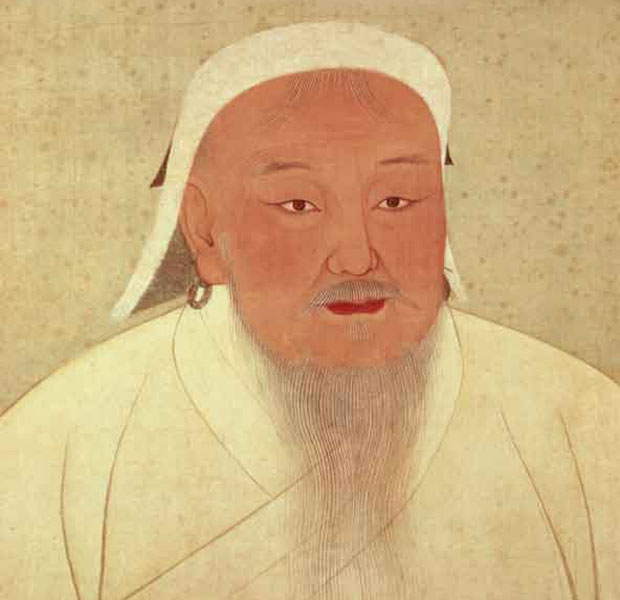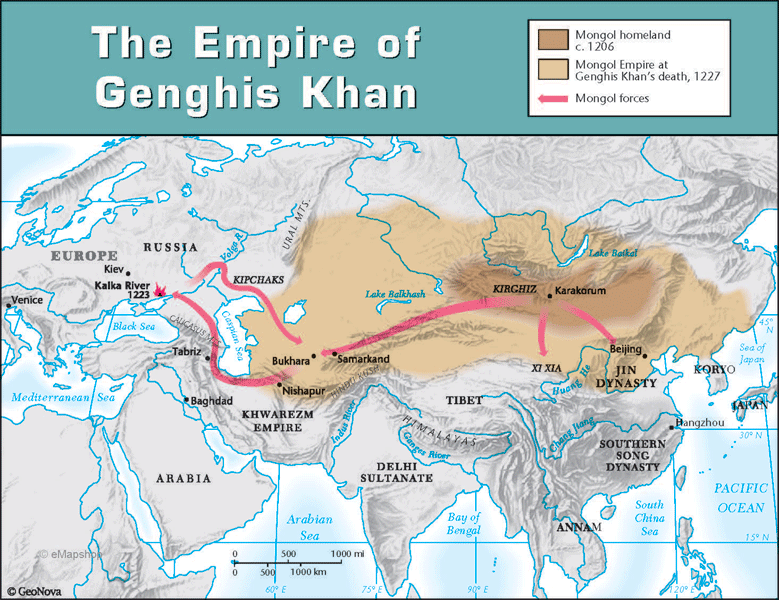Mongols for centuries lived on the vast steppes of Asia, until appeared among them a man who united them, and then created the largest land empire in world history. His name was Temujin, though better known as Genghis Khan. One of the greatest leaders in the history of mankind was the ruthless murderer and yet tolerant ruler.
Tribesmen of Temujin did not differ much from other nomadic peoples, acting assemblage of tribes and clans, merging and collapsing. They didn’t build permanent settlements, but moved around the steppe in search of fodder for cattle and horses. The first unsuccessful attempt to unify the Mongolian tribes took in the first half of the twelfth century, great-grandfather Genghis Khan – Kabul. Its failure rather not surprising, because the steppe countries usually quickly fell apart, and the most common reason for this was the death of their creator and quarrels about his successor.
It’s not clear when and where was born the famous great-grandson of Kabula. For sure it was in the middle of the twelfth century. He apparently born with a lump of clotted blood in his hand, which was considered omen for the future. The boy lived in poverty with his mother and her six brothers. When he was eight years in unclear circumstances, his father died.
It is worth noting that in Europe, to be known as the Tartars, Mongols, Tartars, although in fact they were just one of the Mongol tribes, not very important. Perhaps this was due to the similarity of the names of Tartar, which is ancient, Greek hell – attacking Mongols could actually spend messengers of hell.
Already in his youth Temujin was ruthless and cruel – he killed his half brother during an argument about a captured bird, but also he was brave and tough – he escaped from captivity, encased in a heavy wooden logs. He had a precious gift to win people over and secure the loyalty. When he reached the age of majority, he began a triumphal march to power. After several impressive victories over other tribes around 1200 he was elected on Khan – the leader. It remains a mystery how he could unite the Mongolian tribes. Genghis Khan believed that it was meant to be, because it was chosen by the supreme deity. By the way he changed the name form Blue Heaven to Eternal Heaven. For 1206 year he has united all the tribes of Central Asia and was elected to the great Khan.
When he did this, he moved to conquer the world. He was deeply convinced that this is the will of the Eternal Heaven. He first conquered northern China, then the Arab states in Central Asia. He Applied the simple tactic: those who surrendered without a fight, he gave life and provide conditions for the development of his empire. Those who resisted, he ruthlessly murdered, and their cities leveled with the ground. His actions in this part of Asia, modern historians proclaimed one of the greatest acts of genocide in world history.
Genghis Khan was the ruler of the contradictory nature. On the one hand it can be regarded as a criminal guilty of genocide, on the other he introduced religious tolerance, which was sought in vain this time in Europe. Travelers wandering the Mongol empire marveled dominant order. You could travel one thousand kilometers without a weapon and not be not once attacked, robbed or imprisoned (in Europe at the time it was unthinkable). This order was owed organizational talents of Genghis Khan, who created a vast area smoothly running state. Mongol Empire during its greatest development in the mid-thirteenth century, the area covered today: Mongolia, China, most of Russia, Iran, Afghanistan, Pakistan, Ukraine, reached even to the eastern Polish border.
The circumstances of the death and burial of the creator of the Mongol Empire remain to this day a mystery Sources say very little about the last days of life of the ruler. “Secret History of the Mongols” states only: “In the Year of the Pig (1227) Genghis Khan has joined to heaven” and immediately goes to the appointment of his successor. According to some sources, the ruler died in a fall from a horse, according to the other was killed in a battle with the North Chinese people Tanguts. Later Chinese chronicles fairy story, which today is part of Mongolian folklore.
Guilty Genghis Khan’s death was to be the daughter of the emperor who was beaten by him. Mongolian ruler coveted because of its extraordinary beauty. A woman after the death of his father agreed to spend the night with Khan. Then she killed him (or at least crippled) with hidden in the robes knife. Then she threw herself into the Yellow River (Huang He), which the Mongols named after the River Princess. This tragic story has probably little to do with facts. And how was it really? Historians are trying to solve this puzzle, but unfortunately, not everything can be explained. It is not clear, for example, where Genghis Khan died. Historical sources stubbornly silent, while the folk tradition indicates several places.
Ruler was buried secretly in a place that still remains unknown. From time to time attempts are made to identify it, but the chances are minimal. The early chroniclers agree that the Mongolian graves were perfectly masked. The location of the tomb of Genghis Khan knew only a few. In addition, the study effectively impede the Mongols themselves, who believe in the legend which states that the discovery of the tomb of the great ruler would mean the end of their nation. Treasure hunters believe that in tomb of Khan are inexhaustible wealth. Another sentences are experts. At the turn of the century there were several large, equipped with modern technology expeditions in search of the final resting place of Genghis Khan, but the result was always the same. Apparently, the whole affair involved the secret services are also regional powers: China and Japan.

